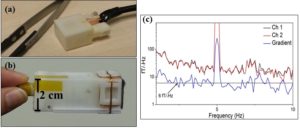 The picture above shows one our very early OPM prototypes (made back in Dec. 2012) which helped convince ourselves (and NIH) the feasibility of building practical, non-cryogenic sensors to potentially replace the SQUIDs. The prototypes were fragile and needed fiber-coupled external high power lasers and complex laboratory electronics, but the performance was very good even in the early stages. While the commercial version is now highly engineered, the basic architecture remains the same. Further reading: Phys Med Biol. 2013 Nov 21; 58(22): 8153–8161.
The picture above shows one our very early OPM prototypes (made back in Dec. 2012) which helped convince ourselves (and NIH) the feasibility of building practical, non-cryogenic sensors to potentially replace the SQUIDs. The prototypes were fragile and needed fiber-coupled external high power lasers and complex laboratory electronics, but the performance was very good even in the early stages. While the commercial version is now highly engineered, the basic architecture remains the same. Further reading: Phys Med Biol. 2013 Nov 21; 58(22): 8153–8161.